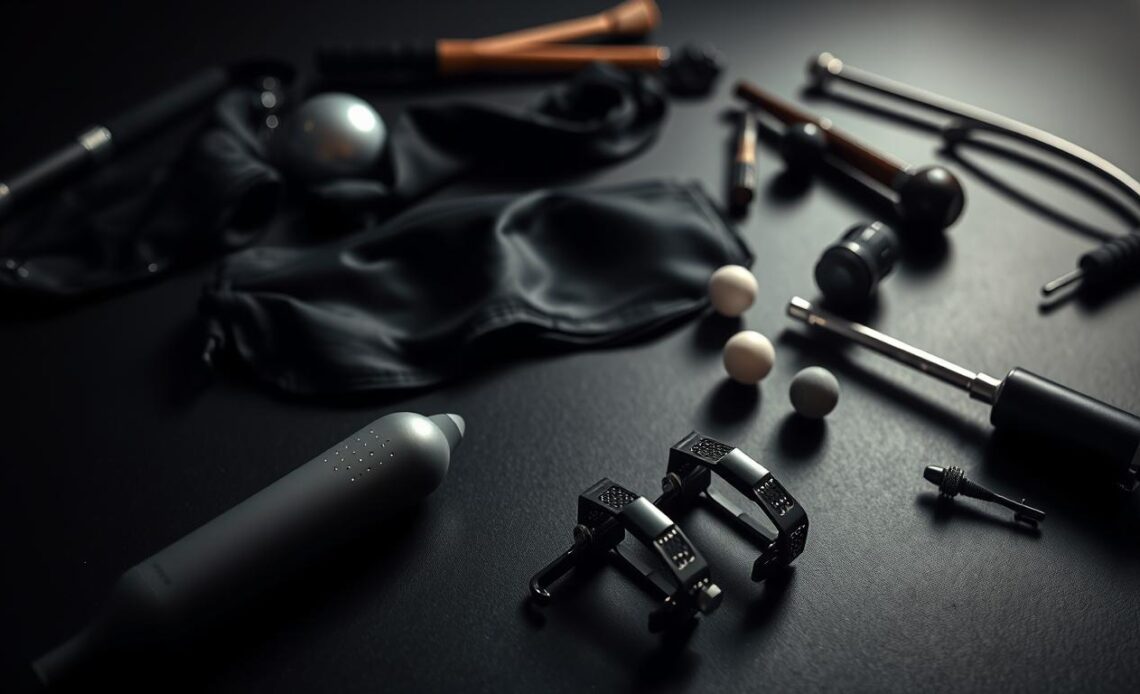
Exploring the world of tease and denial play can be a thrilling experience for couples looking to enhance their intimacy. This type of play involves building sexual tension through stimulation without allowing release, creating a heightened sense of anticipation and pleasure. By incorporating specialized toys into tease and denial activities, partners can further intensify the experience, fostering a deeper connection and more intense orgasms.
Effective tease and denial play relies heavily on communication, consent, and trust between partners. As we delve into this comprehensive guide, we’ll explore the benefits, techniques, and safety considerations associated with tease and denial play, providing you with the knowledge to engage in this exciting and intimate experience.
Key Takeaways
- Tease and denial play involves building sexual tension without release.
- Incorporating toys can enhance the experience for both partners.
- Communication, consent, and trust are crucial for safe and enjoyable play.
- This type of play can lead to heightened pleasure and deeper connection.
- Our guide will cover toy recommendations, techniques, and safety considerations.
Understanding Tease and Denial Play
Tease and denial play is a complex and multifaceted aspect of human intimacy that involves a delicate dance between anticipation and gratification. Delving into orgasm denial isn’t just for the thrill; it’s a path to deeper understanding and connection with your body and your partner’s.
What is Tease and Denial?
Tease and denial is a form of sexual play where one partner teases the other, bringing them to the brink of orgasm and then denying them release. This can create a heightened state of arousal and pleasure, as the anticipation builds and the desire becomes more intense.
It’s an experience that not only involves physical sensations but also deeply engages the mind, playing with the psychological aspects of desire and control. By exploring tease and denial, individuals can discover new dimensions of their sexuality and deepen their connection with their partner.
The Psychology Behind the Pleasure
The pleasure derived from tease and denial play is deeply rooted in psychology. The brain’s reward system responds to delayed gratification by potentially making the eventual release more intense and satisfying. This play can create a state of heightened arousal that extends beyond the physical, engaging the mind in powerful ways.
The psychological aspects of tease and denial involve the thrill of anticipation, the surrender of control, and the dynamics of power and vulnerability. By embracing these elements, individuals can experience a deeper level of intimacy and connection, as well as a more profound understanding of their own desires and responses.
As we explore tease and denial, we find that it’s not just about the act itself but about the experience it creates. It’s about building anticipation, exploring the boundaries of desire, and discovering new levels of intimacy and connection.
Essential Toys for Your Tease Denial Toys Guide
Toys play a crucial role in enhancing the tease and denial experience, offering a range of sensations and experiences. The right toys can heighten anticipation, intensify sensations, and create a more immersive experience for both the dominant and the submissive.

Chastity Devices
Chastity devices are a staple in tease and denial play, allowing the dominant to control the submissive’s access to pleasure. These devices come in various forms, from simple lock-and-key models to more complex designs that incorporate additional features like stimulation or monitoring. When choosing a chastity device, consider the material, comfort, and security it offers.
Vibrators and Stimulators
Vibrators and stimulators are excellent tools for tease and denial, offering a range of sensations that can be controlled remotely or manually. They can be used to tease the submissive, bringing them to the edge of orgasm before denying them release. The variety in shapes, sizes, and functions allows for a tailored experience that can be adjusted according to the submissive’s preferences and boundaries.
Sensory Tools
Sensory tools, including blindfolds, feathers, ice, warming oils, and pinwheels, play a significant role in enhancing the tease and denial experience. Sensory deprivation, such as using blindfolds, heightens other senses, making every touch more intense. Temperature play with ice or warming oils can create contrasting sensations, while textured toys like feathers or fur mitts offer different tactile experiences.
Combining these tools can create a rich and unpredictable experience. For example, using a blindfold with temperature play or textured toys can significantly heighten the submissive’s sensitivity and anticipation. It’s essential to introduce these tools safely, especially when involving temperature or sensation play, to avoid discomfort or injury.
Setting the Scene: Preparation and Communication
Tease and denial play isn’t just about the toys used; it’s about creating an experience that is both pleasurable and safe for everyone involved through proper preparation and communication. When engaging in any form of BDSM activity, including tease and denial, establishing a clear understanding between partners is crucial.
Discussing Boundaries and Desires
Before starting any tease and denial play, it’s essential to have an open and honest conversation with your partner about your desires, boundaries, and any concerns you may have. This discussion should cover what you both are comfortable with and what is off-limits, ensuring that you’re both on the same page and can fully enjoy the experience.
Establishing Safe Words and Signals
Establishing a safe word or safe word signal is a fundamental aspect of any BDSM activity, including tease and denial. Safe words are crucial for maintaining consent and allowing the submissive partner to communicate their limits or discomfort during play. A common method is the traffic light system: green for go, yellow for slow down, and red for stop. It’s also important to discuss non-verbal signals for situations where verbal communication is difficult.
| Safe Word System | Description | Action |
|---|---|---|
| Green | Proceed with the activity | Continue play as desired |
| Yellow | Caution or slow down | Adjust play to comfort level |
| Red | Stop the activity | Immediately cease play |
Respecting safe words immediately and without question is vital. After using a safe word, it’s beneficial to debrief with your partner to understand what triggered its use and how to adjust future play accordingly. This not only enhances the experience but also strengthens the bond between partners through trust and understanding, ultimately improving control and enjoyment in tease denial play.
The Art of Edging: Building Anticipation
For those exploring tease and denial play, edging is a technique that heightens sexual tension and intensifies pleasure. Edging involves bringing oneself to the brink of orgasm and then stopping, creating a cycle of arousal and restraint that can be repeated multiple times. This practice not only builds anticipation but also enhances control over one’s orgasmic responses.
Edging Techniques
Effective edging requires a combination of self-awareness and control. Start by understanding your body’s responses to different types of stimulation. Vibrators and other sex toys can be particularly useful in this exploration, allowing for precise control over the intensity and type of stimulation. The key is to recognize the point just before orgasm and then stop or reduce stimulation to prevent release.
Some individuals find it helpful to establish a routine or pattern in their edging practice, while others prefer a more spontaneous approach. Experimenting with different techniques, such as varying the speed or intensity of stimulation, can also enhance the edging experience. For those in a relationship, incorporating a partner into edging can add an additional layer of intimacy and control.
Benefits of Prolonged Arousal
The benefits of edging extend far beyond the immediate sexual gratification. Prolonged arousal through edging can lead to intensified orgasms when release is finally allowed. This practice can also enhance sexual awareness and control, allowing individuals to better understand their responses and communicate their needs to a partner.
| Benefits | Description |
|---|---|
| Enhanced Control | Edging helps in managing premature ejaculation, giving you more control over timing. |
| Increased Intimacy | For couples, edging can enhance communication and emotional connection. |
| Greater Sexual Awareness | Edging encourages exploration and understanding of sexual responses. |
| Intensified Orgasms | Delaying orgasm builds up sexual tension, making the eventual climax more intense. |
For more information on incorporating edging into your tease and denial play, visit this resource
Power Dynamics in Tease and Denial Play
The essence of tease and denial lies in the intricate dance of power between partners. This dynamic is not just about one partner having control over the other; it’s a complex interplay that can enhance the erotic experience for both parties involved.
Dominant and Submissive Roles
In tease and denial play, the roles of dominant and submissive are crucial. The dominant partner takes the lead, deciding when and if the submissive partner can reach climax. This role-playing is not just about exerting control but also about the trust and surrender that the submissive partner must embrace. The act of surrendering control can be deeply erotic, fostering a stronger emotional and physical connection between partners.
The dynamic between dominant and submissive can shift, adding an element of unpredictability that keeps the experience exciting. This shift in power dynamics can be thrilling for both partners, as it requires continuous communication and trust.
Psychological Elements of Control
The psychological aspects of control in tease and denial play are just as important as the physical sensations. The anticipation and uncertainty that come with not knowing when or if one will be allowed to climax create a powerful psychological state. Verbal cues, such as commands or teasing language, can further enhance this experience, making it more engaging and immersive.
The trust required for this level of psychological control can strengthen the bond between partners. It’s about understanding each other’s desires and boundaries, creating a safe space for exploration. The psychological elements of tease and denial can fulfill different needs, from stress relief to feeling valued, making it a versatile and enriching experience.
Sensory Deprivation for Enhanced Pleasure
The art of tease and denial is elevated through the strategic use of sensory deprivation. By limiting our visual input or restricting movement, we can heighten our other senses, making every touch a spark of sensation. This approach can transform a simple caress into a thrilling exploration, making the ordinary feel extraordinary.
Using Blindfolds and Restraints
Blindfolds and restraints are tools that can significantly enhance the tease and denial experience. By removing visual input, we become more attuned to touch, sound, and other sensations. Restraints can further intensify this experience by limiting our ability to move, thus making us more receptive to the sensations we are experiencing.
Heightening Other Senses
When visual input is removed, our other senses become more acute. Techniques such as whispering, using unexpected sounds, or playing erotic audio can heighten auditory experiences during blindfolded play. Incorporating taste and smell through flavored lubes or essential oils can also add new dimensions to tease and denial play. The anticipation of not knowing what sensation comes next can intensify the experience of each touch or stimulation.
| Sensory Deprivation Method | Effect on Experience | Techniques to Enhance |
|---|---|---|
| Blindfolds | Heightens touch and auditory senses | Whispering, erotic audio |
| Restraints | Intensifies sensations, limits movement | Using different textures, temperature play |
| Flavoured Lubes/Essential Oils | Adds taste and smell dimension | Varying flavors, scent layering |
By understanding and applying these techniques, we can create a more immersive and engaging tease and denial experience. The key is to communicate with our partner and adjust our approach based on their responses and comfort level.
Popular Tease and Denial Games
Games can be a fantastic way to explore tease and denial, introducing elements of surprise, anticipation, and control into your intimate play. By incorporating games into your tease and denial experiences, you and your partner can deepen your connection and explore new dimensions of pleasure.

The Countdown Game
The Countdown Game is a simple yet thrilling way to build anticipation. In this game, one partner is stimulated until they are on the verge of orgasm, then stopped. The process is repeated, with a countdown beginning from a certain number, decreasing with each round until it reaches zero. This game heightens the sense of anticipation and can lead to a more intense orgasm when finally permitted.
The Obedience Game
In the Obedience Game, the submissive partner is given tasks to perform by the dominant partner. Compliance is rewarded, potentially with the permission to reach orgasm, while failure may result in denial or additional tasks. This game explores power dynamics and can enhance the intimacy between partners.
Random Chance Denial
Random Chance Denial introduces an element of unpredictability into tease and denial play. Using a random number generator or other chance mechanism, the dominant partner decides whether to grant or deny orgasm. This game can heighten the sense of anticipation and make the experience more exciting.
The Orgasm Permission Game
The Orgasm Permission Game is a thrilling way to explore sexual power dynamics, as discussed on HelloNancy. In this game, the submissive partner must ask for permission to reach orgasm, and the dominant partner decides whether to grant it. This game not only involves physical control but also psychological play, enhancing intimacy and trust.
These games offer a range of ways to explore tease and denial, from building anticipation to exploring power dynamics. By incorporating elements of surprise and control, you and your partner can create a more engaging and fulfilling experience.
Advanced Techniques for Experienced Players
For those who have mastered the basics of tease and denial play, it’s time to explore advanced techniques that can elevate the experience. As we continue to explore the realm of tease and denial, we find that there are several sophisticated strategies that can enhance the play, making it more engaging and thrilling for both partners.
Ruined Orgasms
One advanced technique involves the concept of ruined orgasms, where the climax is intentionally disrupted or diminished, leaving the submissive partner in a state of heightened arousal and frustration. This can be achieved through various methods, such as stopping stimulation just before climax or using specific toys that prevent or limit orgasm. The goal is to create a sense of anticipation and longing that is both pleasurable and torturous.
To incorporate ruined orgasms into your play, consider the following strategies:
- Use a vibrator to bring your partner to the brink of orgasm, then suddenly stop.
- Employ manual stimulation techniques, building up to a climax before ceasing all touch.
- Utilize chastity devices to physically prevent orgasm, heightening the sense of denial.
Long-Distance Denial Play
In the tantalizing world of long-distance relationships, keeping the spark alive requires creativity, especially when it comes to orgasm denial. Leverage technology to shrink the physical gap. Apps like We-Vibe allow you to control intimate toys remotely, adding a tangible element to your teasing texts. This technology enables partners to maintain control and intimacy despite the distance.
To engage in long-distance denial play, consider establishing protocols and rules, such as check-ins, permission systems, and verification methods. Chastity devices can also be incorporated to provide physical enforcement of denial agreements. Creative strategies like scheduled calls, surprise instructions, or timed tasks can help maintain the psychological aspects of tease and denial across distance.
Some key elements to focus on include:
- Using app-controlled toys to create interactive tease and denial experiences.
- Establishing clear protocols for long-distance denial play.
- Maintaining safety and consent through regular check-ins and verification methods.
By embracing these advanced techniques, partners can deepen their connection and intensify their tease and denial play, regardless of the physical distance between them.
Safety Considerations When Using Toys
When engaging in tease and denial play, safety should always be the top priority. Ensuring both physical and emotional well-being is crucial for a positive experience. This involves understanding the proper use of toys and maintaining open communication with your partner.
Physical Safety Tips
To avoid any adverse effects during tease and denial play, it’s essential to follow some basic physical safety guidelines. Always inspect your toys before use, checking for any signs of wear or damage. Ensure that any restraints or chastity devices are not too tight, as this can cause discomfort or injury. Regularly cleaning your toys is also vital to prevent infections.
| Safety Aspect | Precaution |
|---|---|
| Toy Inspection | Check for wear and damage before use |
| Restraints and Devices | Ensure they are not too tight |
| Toy Hygiene | Regularly clean toys to prevent infections |
Emotional Well-being During Play
Emotional safety is just as important as physical safety during tease and denial play. This form of BDSM activity can involve intense feelings and vulnerability. Regular check-ins with your partner can help ensure that both parties are comfortable and consenting throughout the experience. Establishing a safe word or signal is crucial, allowing the submissive partner to express any discomfort or need to stop.
As emphasized by experts, “The cornerstone of any BDSM activity, including tease and denial, is consent and mutual respect.” Maintaining this foundation ensures a positive and enjoyable experience for all involved.
By prioritizing both physical and emotional safety, individuals can fully enjoy the thrill of tease and denial play while minimizing risks. This includes being mindful of denial periods and ensuring that the tease aspect remains enjoyable and consensual.
Aftercare: The Essential Final Step
Tease and denial play, like any intense BDSM activity, requires thorough aftercare to maintain emotional and physical health. Aftercare is not just a nicety; it’s a necessity that ensures both partners feel safe, comforted, and cared for after a session.

Physical Aftercare
Physical aftercare involves addressing any physical needs or discomfort that arose during the play. This can include removing restraints or other toys, providing comfort, and checking for any injuries. For example, if chastity devices were used, it’s essential to clean and possibly remove them to prevent discomfort or injury. Cuddling and gentle touch can also be very comforting, helping to release tension and promote a sense of safety and well-being.
Emotional Aftercare
Emotional aftercare is just as crucial, if not more so, as it involves processing the feelings and emotions that arose during the experience. This can include discussing the session, acknowledging any feelings of vulnerability or excitement, and reassuring each other of the care and respect that was shared during the play. Techniques such as verbal affirmations can be particularly helpful, reinforcing the consensual and caring nature of the play. It’s also a time to address any “sub drop” or “dom drop” that may occur, providing reassurance and comfort to manage these emotional responses.
Some strategies for effective emotional aftercare include debriefing after sessions to discuss what worked well and what might be adjusted in future play. This not only helps in strengthening the bond between partners but also enhances future tease and denial experiences by ensuring that both partners’ emotional needs are met.
- Discussing the session to process feelings and emotions.
- Providing verbal affirmations to reinforce care and respect.
- Addressing any emotional drops or negative feelings.
- Debriefing to adjust and improve future sessions.
By prioritizing aftercare, partners can ensure that their tease and denial play remains a positive and enriching experience, fostering a deeper connection and understanding of each other’s needs and desires.
Conclusion: Embracing the Journey of Pleasure and Control
As we conclude our exploration of tease and denial play, it’s clear that this intimate practice offers a unique blend of pleasure and control. By understanding the psychology behind tease and denial, selecting the right toys, and prioritizing communication and consent, couples can embark on a journey that deepens intimacy and enhances pleasure. This tease denial experience can evolve within a relationship, potentially strengthening the bond between partners. To start, couples can begin with simple exercises and gradually expand their play as comfort and experience grow, ultimately leading to a more fulfilling release. For those new to using sex toys, resources like overcoming anxiety about using sex toys can be helpful. By embracing tease denial thoughtfully, couples can discover new pleasures and connections, culminating in a satisfying release.
FAQ
What is the purpose of using chastity devices in tease and denial play?
We use chastity devices to restrict access to our genitals, heightening the sense of control and anticipation in our play. This can be a powerful tool for building arousal and prolonging the experience.
How do we establish a safe word or signal for our tease and denial games?
We discuss and agree upon a safe word or signal before play begins, ensuring that we can communicate our boundaries and limits clearly. This allows us to play with confidence, knowing that we can stop or adjust the play if needed.
What are some benefits of incorporating sensory deprivation into our tease and denial play?
Sensory deprivation, such as using blindfolds, can heighten our other senses and increase our sensitivity to touch and stimulation. This can lead to a more intense and immersive experience, as we focus on the sensations and build anticipation.
How can we ensure our physical and emotional well-being during tease and denial play?
We prioritize our physical safety by using devices and toys that are designed for our play, and by following proper usage guidelines. We also check in with each other emotionally, ensuring that we’re both comfortable and consenting throughout the experience.
What is edging, and how can we incorporate it into our tease and denial play?
Edging involves bringing ourselves to the brink of orgasm, then stopping or reducing stimulation to prolong the experience. We can incorporate edging into our play by using vibrators or other stimulators, and by varying the intensity and duration of our stimulation.
How can we make our tease and denial play more engaging and exciting?
We can mix things up by trying new games, such as the Countdown Game or the Orgasm Permission Game, and by incorporating different toys and devices into our play. We can also experiment with different levels of control and submission, exploring the psychological elements of our play.
What is aftercare, and why is it important in tease and denial play?
Aftercare involves caring for each other’s physical and emotional needs after play, ensuring that we’re both comfortable and supported. This can include discussing our experience, providing comfort and reassurance, and engaging in relaxing activities together.

